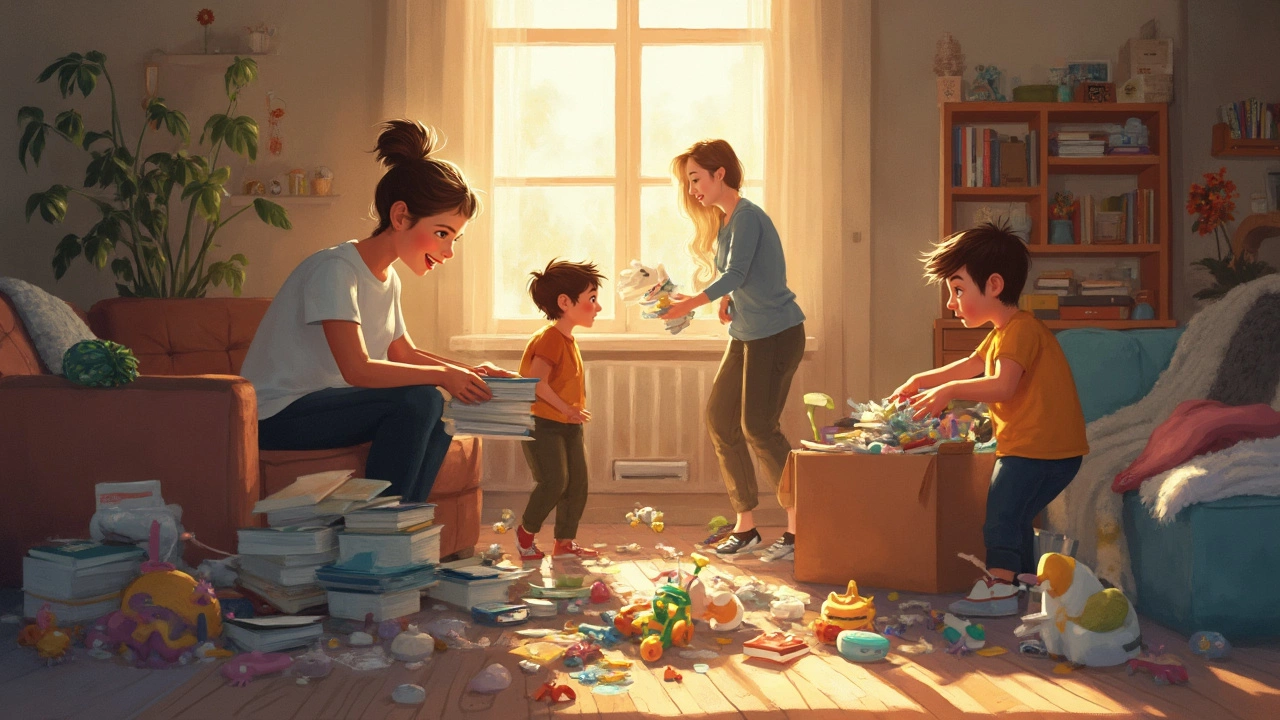Standing in a messy room feels like staring down a mountain you never signed up to climb. You see piles, stacks, and scattered stuff everywhere—so where do you even start? Here’s the truth: you don’t have to deal with it all at once. The key is picking one tiny spot, not the whole house.
Grab a trash bag. Choose the easiest target—maybe a kitchen junk drawer or even just your purse. Clear that out first. Dropping a tiny win right at the start tricks your brain into believing you can handle more. Studies show small successes set off a little shot of motivation. So pick a spot, spend 15 minutes, and actually finish.
If you can’t make big decisions today, don’t sweat it. Toss out real trash and anything clearly expired or broken. Ignore “should I keep this?” for now. The first step is just to make a dent.
- Why Clutter Feels So Overwhelming
- The Power of Starting Small
- Simple Steps to Build Decluttering Momentum
- Making It Stick: Keeping Clutter at Bay
Why Clutter Feels So Overwhelming
Looking at too much clutter fires up your stress and makes you want to run for the hills. That’s not just in your head—researchers at UCLA found that people with cluttered homes had higher levels of the stress hormone cortisol, especially women. Your brain sees every pile and thinks, “unfinished task.” That’s draining, so it’s no wonder you feel wiped out by the mess.
Too much stuff also slows you down. Princeton University scientists discovered that clutter competes for your attention, making it harder to focus and even raising your anxiety. It’s like trying to have a phone call in a room where three TVs are blaring at once.
Clutter isn’t just about looks, either. It makes basic day-to-day things more annoying. Lost keys, late bills, and last-minute scrambles for that one thing you swear you just put down all waste time and create extra mental load. It all adds up, bit by bit.
Here’s a quick breakdown of how clutter messes with your head and your time:
- Home organization can feel impossible when every surface is covered.
- Your brain gets tired sorting through all the “stuff” every day.
- You waste time looking for things you need.
- The mess can affect sleep and moods without you even noticing.
Check out these numbers to see just how real the struggle is:
| Stat | What It Means |
|---|---|
| 23% | Of adults say they regularly pay bills late because they lose them in the clutter (according to a National Association of Productivity & Organizing Professionals survey). |
| 80% | Of clutter is due to disorganization, not lack of space. |
No wonder clutter can make you want to shut the door and walk away. But knowing it’s totally normal to feel overwhelmed is the first step in getting control.
The Power of Starting Small
It’s so much easier to keep scrolling on your phone than to face a whole messy house. But here’s the thing: research from Princeton University found that clutter makes it hard for your brain to focus or process info—so those tiny steps really do matter for getting unstuck.
The biggest myth people believe is that you have to block off hours and tackle everything at once. Actually, just clearing a single shelf, basket, or corner can fire up your motivation way more than a big exhausting session. Small wins add up—and yes, your brain sets off a hit of dopamine when you actually complete a simple job.
If you need ideas on where to start small with your clutter or try home organization tips, here are some easy spots that make a real difference fast:
- Throw out expired food from the fridge or pantry.
- Empty the main junk drawer.
- Clear off just the coffee table.
- Sort your mail pile—just toss old stuff, don't organize yet.
- Pick ten things from your closet to donate or toss.
This is not about being perfect—just moving the needle forward. Some professional organizers even say two-minute tasks are ideal. If something takes less than two minutes, do it now. It works because seeing clear surfaces or fresh-empty spaces helps you feel in control instead of trapped by your stuff.
Everybody’s home is different, but every bit of declutter progress works the same way. The less overwhelming you make the task, the higher your odds of sticking with it long-term.
| Task | Average Time (minutes) |
|---|---|
| Clean junk drawer | 8 |
| Toss expired food | 5 |
| Clear coffee table | 4 |
| Donate 10 clothing items | 12 |
Instead of waiting for a perfect day to overhaul your home, use those tiny windows of free time. Any small bite out of your tidy home goal is progress. Just pick a spot and start. That’s how you beat clutter—one little mess at a time.

Simple Steps to Build Decluttering Momentum
The scariest part of decluttering? Getting started—and then keeping the energy up. Luckily, you can build serious declutter momentum by sticking to some super doable basics, no fancy hacks needed. The trick is turning big messes into bite-sized wins, one step at a time.
Here’s how to keep moving forward without burning out:
- Set a Timer: This isn’t about deep-cleaning all day. Pick a short, non-scary time (think 15–20 minutes). Set a timer and do as much as you can. Making it time-limited keeps overwhelm away and makes it way more likely you’ll do it again tomorrow.
- Pick by Category, Not Room: A fun fact you might not know: Marie Kondo recommends sorting by category (like all your makeup, or every stray mug), not by room. It makes you see the real numbers and stops you from just shifting piles around. Try it with shirts, books, or even all your cords.
- Use the Four-Box Method: Find four empty boxes or bags. Label them: "Keep," "Donate," "Trash," "Decide Later." As you go through stuff, drop each item into a box. This makes decisions faster and helps you actually move items out when done. Don’t let things linger in the “Decide Later” box for too long—set a reminder to revisit it next weekend.
- Get Stuff Out Fast: The second you fill a trash or donate bag, put it in your car or near the front door. Research suggests people are less likely to change their mind or "rescue" items if they leave them out of sight right away. Don’t let old stuff linger in the hall—take it out fast, so you feel the difference.
Even just one pass through the steps above keeps your home organization on track and stops clutter from building up again. If you’re curious about what you could actually accomplish in a week of short sessions, check this out:
| Day | Area Tackled | Time Spent |
|---|---|---|
| Monday | Car glove box and trunk | 15 minutes |
| Tuesday | Junk drawer | 20 minutes |
| Wednesday | Bathroom cabinet | 20 minutes |
| Thursday | Nightstand & under bed | 15 minutes |
| Friday | Purse or backpack | 10 minutes |
See how much progress stacks up with just a little daily effort? Keeping your tidy home dream totally reachable just by building this simple habit. If you slip up, don’t stress—just pick up where you left off.
Making It Stick: Keeping Clutter at Bay
It’s one thing to hit the reset button on your space, but keeping a tidy home long term can feel like trying to hold back a tidal wave. The best part? It totally comes down to habits, not perfection. Most people don’t become neat freaks overnight—real change is built on small routines you barely notice once they stick.
One helpful habit is the “one in, one out” rule. Buy a new shirt? Toss or donate an old one. This keeps your space from filling up again without you even realizing it. Next up, set yourself a two-minute tidy every evening. Quick wins mean you never have to do a giant clean-up again. Even if it’s just clear the counters or put away shoes, it matters more than you think.
Here’s what helps most people stay on top of clutter:
- Assign a “home” to everything you keep—if it doesn’t have a spot, it’s more likely to get dumped somewhere random.
- Make it a family rule: nothing left out before bedtime. If you have kids, turn it into a game or race.
- Use baskets, drawers, and labels for everyday stuff so you aren’t hunting for keys or chargers every morning.
- Schedule a regular “edit” every month. Set a reminder on your phone and give yourself ten minutes to look for stuff you no longer use.
And here’s a cool fact: a study out of UCLA found that families who did small daily cleanups had much lower stress hormones than those who let clutter pile up. So it’s not just about looks—getting started with home organization can even help you feel calmer.
If you love a good visual, try posting a simple declutter tips checklist on your fridge. Crossing off items feels good, and it’s a reminder to keep going, even when life gets busy.
Staying on top of your mess isn’t about being super strict or stressing over every sock out of place. It’s about making little decisions every day that stop clutter before it can take over. Trust the process—you’ll be surprised how quickly these habits become automatic.





